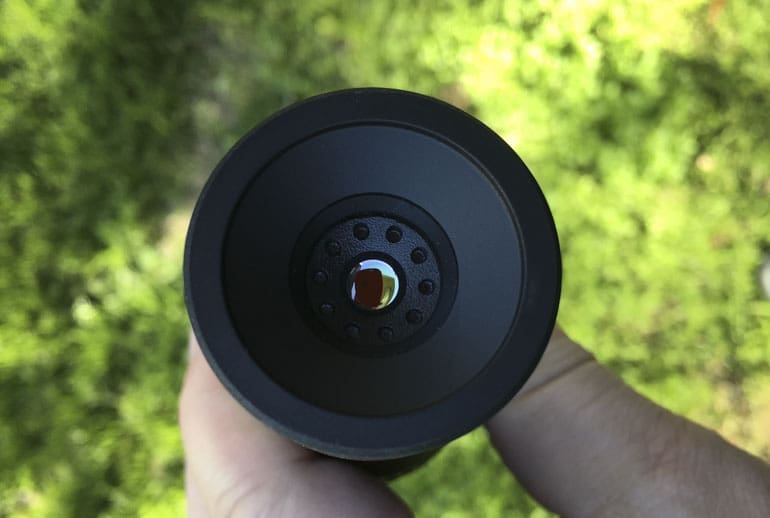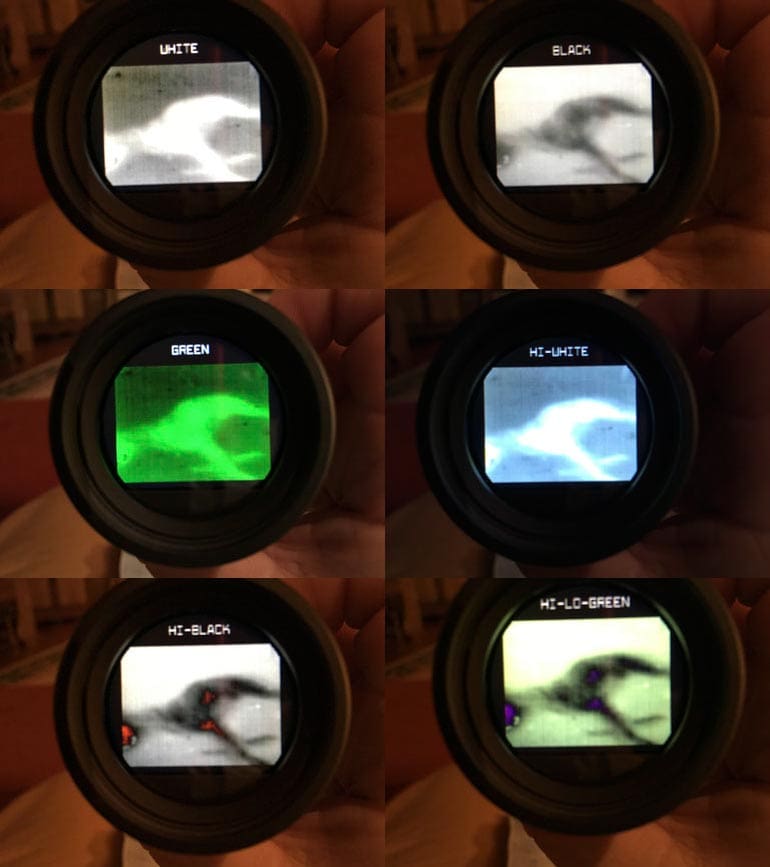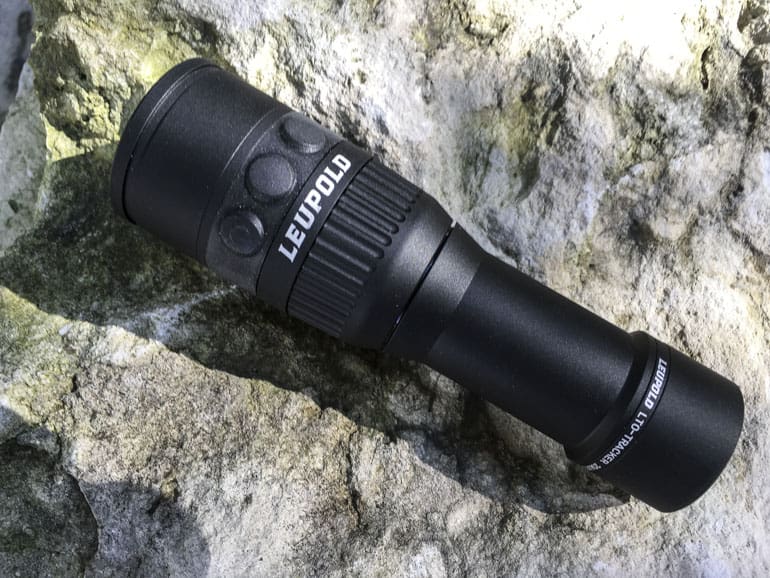If you hunt, particularly if you hunt at night, you know the importance of being able to find your prey after the shot. That’s not always easy. But the advance of lightweight thermal imaging gear has made it much more do-able.
Leupold’s LTO Tracker handheld imagers let you quickly locate game and blood trails no matter what the light conditions. Leupold’s recently updated the two LTO Tracker models and we’ve been playing with one for a few weeks.

The whole thing is just over 5.5 inches long and weighs only 7 ounces, so you can pack it anywhere you need to go. It has digital magnification up to 7X.
It picks critters out of pitch black darkness at 250 yards like it’s broad daylight. It would do the same inside your house if an uninvited two-legged beast lets itself in. And then there are these images taken with the LTO Tracker 2 at 1X.

That’s not a Labrador Retriever. That’s the spot on the carpet where the Lab was laying five minutes before the images were taken with the lights on. That’s how sensitive this thing is. I haven’t tried the HD version, but I’d imagine it’s even more detailed.
This kind of technology doesn’t come cheap. MSRP for the two updated units: LTO Tracker 2 – $1039, LTO Tracker 2 HD – $1559.
Here’s Leupold’s press release . . .
Relentless Recovery: Leupold Upgrades Handheld Thermal Line with Launch of LTO Tracker 2 and LTO Tracker 2 HD
BEAVERTON, Ore. — Leupold & Stevens, Inc. has upgraded its handheld thermal imager line with the introduction of the LTO Tracker 2 and LTO Tracker 2 HD, which represent the most recent evolution in the company’s award-winning thermal imaging product line.
Designed to be compact and light enough to take on even the farthest backcountry hunt, the original LTO Tracker showed hunters the heat signature of game, blood trails and more. The new LTO Tracker 2 and LTO Tracker 2 HD deliver the same premier performance while providing a friendlier user interface and changing the game entirely with the introduction of the new Beacon Mode.
Designed to extend usability and help consumers track downed game more efficiently than ever before, Beacon mode quickly recalibrates the screen for increased detection in hot environments. When activated in one of three Hi-Bright screen colors, Beacon mode detects the warmest object in the active image and rebalances all the Hi-bright colors back down to grayscale. The result: The screen is a grayscale color under the Beacon threshold until a “warmer” spot is detected and displayed as a Hi-Bright condition. It is featured in both the LTO Tracker 2 and the LTO Tracker 2 HD.
“When we launched the LTO Tracker, we knew it was just the beginning,” said Eric Overstreet, Product Line Manager for Leupold & Stevens, Inc. “Beacon mode delivers a feature end users have been asking for by extending the usability of both the LTO Tracker 2 and the LTO Tracker 2 HD into the midday hours.”
The LTO Tracker 2 features a user dimmable display, 204×204 pixel thermal sensor resolution, and 206×156 pixel thermal sensor. It has a 600-yard overall detection distance on thermal targets and a 250-yard typical deer detection distance.
The LTO Tracker 2 HD has a user-dimmable, 390×390 full-circle display. 320×240 thermal sensor delivers twice the resolution over the LTO Tracker 2 and has an overall detection distance of 750 yards with a 300-yard typical deer detection distance. The unit ships with lens covers and a neoprene cover that also helps insulate your hands on cold winter days.
Both units feature six color palettes to match your conditions and are capable of detecting temperatures from -40°F to 572°F and will perform in temperatures from -4°F to 140°F.
The LTO Tracker 2 and the LTO Tracker 2 HD are designed and assembled in the United States.
For more information on Leupold® products, please visit us at Leupold.com.
Join the discussion on Facebook, Facebook.com/LeupoldOptics, on Twitter at Twitter.com/LeupoldOptics or on Instagram at Instagram.com/LeupoldOptics.
Founded in Oregon more than a century ago, Leupold & Stevens, Inc. is a fifth generation, family owned company that designs, machines and assembles its riflescopes, mounting systems and tactical/Gold Ring® spotting scopes in the USA. The product lines include rifle, handgun and spotting scopes; binoculars; rangefinders; mounting systems; and optical tools, accessories and Pro Gear.





That’s really not a bad price. I’ve oftentimes wondered why the Fish &Game won’t let a person use a trail dog to locate downed or wounded game. I did anyway because” fuckem till we get caught” kinda my attitude on a lot of stuff. The bow hunters would benefit the most
Yeah the price is fantastic, consider a trijicon anything w/o being nightvision or thermal is around the same. I’m glad to see prices on night optics reach affordable levels.
You’re not supposed to use dogs to track deer? I’m not a hunter but I helped someone this bow season and we used a dog to track.
I wasn’t that impressed with the dog but it got on the scent the third time. I’d rather have this optic. Huge force multiplier to defend my house out here in the country.
Not in this State on the dogs.
Why does thermal have to be so effen expensive?
I’ve got a gen 3 night optic that was cheaper than this.
I’d rather have thermal, but wtf?
In this case it’s the cost of miniaturization of the item and the fact that it’s new balanced against how many they expect to sell in the first year.
Econ 101. Literally.
The puzzle is not Econ 101 but the details. Why is thermal imaging equipment so expensive?
One tries to read as if one’s questioner is intelligent. One really does.
Because glass can’t be used for the lenses since it blocks most of the wavelength you’re trying to view
necessitating more expensive lenses and because the market is comparatively small.
Again, Econ 101 if you bother to read about thermal tech at all.
Perhaps you need to learn what is actually Econ and what is Tech. Econ only explains supply/demand/prices. It has nothing to do with the lenses; that is Tech, and that is what was not understood.
Perhaps you need to realize that tech = money. Money = cost. Therefore, tech = cost.
Cost of production materials (component cost), added together, plus the cost of the actual production give you the unit cost of production.
In this case the cost of one of the materials, Germanium, a rare earth metal is often used to make thermal camera lenses and it’s pretty damn expensive. It’s $1500+ per kilogram and sometimes, depending on trading, it can be much closer to $2000/kg. That item, once obtained, then has to be turned into a lens. This ain’t cheap to do either. Precision thermal optics lenses can be tens of thousands of dollars just for the lens.
Now, cost of production per unit and expected unit sales are two of the key variables in determining the point at which a profit can be made. Once you know what profit you want you can determine a sale price.
That is, quite literally, the first couple weeks of Econ 101 at the college level. So, yeah, it is Econ 101 no matter how much you want to argue that it’s not. The price of everything is set by basic economics. Things like thermal optics cost a fuck-load to produce and are not something that has a huge market in comparison to other forms of optics where cheaper materials can be used to make something that sells in much higher quantities. Therefore they’re expensive by comparison and the reason is mostly production cost.
Good grief. His question was about why the tech was expensive. What is the tech? Why is that tech expensive?
Econ 101 that was not.
If someone asked what makes a race car fast, would you say Physics 101?
Good grief almighty.
“Why is that tech expensive?” is an economic question, not a tech question.
When you ask an econ question the answer is: “Economics.”
Further, I answered the “tech question” too since it’s part of the economic reason for the price and is contained in my original reply to Tom. You’re just being intentionally obtuse, can’t write to save your life or you’re ticked that I made an offhand joke to Tom. One I’m fairly confident he didn’t take personally since he probably knows from talking to me for the last few years that I’m not trying to be a dick to him.
I believe that prices will be coming down dramatically, and that everyone will have a couple in 5-10 years. These suckers are essentially all electronics, zero precision ground glass or machined metal, if it costs $1000 today it will be $100 in 10 years, for a far superior product.
Many thermal imagers are based around microbolometer arrays. (A very quick Google search couldn’t confirm but on a guess thats what these use.) Fabricationcompared to CCD arrays, is more complex and more likely to wind up with defects, thus a higher reject per sensor. The front-end processing electronics are also different from CCDs – you “read” the arrays differently.
Bingo.
You get it.
It’s the same as the beginnings of 1080 P plasma TV panels in the 90s. The reject rate was atrocious, the per-unit cost was sky-high. Therefore plasma TVs sold in tiny quantities at the beginning.
The difference between plasma TVs and IR imaging sensors is *market*. EVERYBODY wants an HD TV, very few (relatively speaking) want an IR imaging device.
Therefore, no incentive by the manufacturers to spend the vast sums of money to reduce the cost of production.
We got lucky in the first place that CCD sensors could (to some extent) be re-configured to function as a thermal imaging sensor. That’s where the current 400 dollar units came from, the fact there are *billions* of CCD sensors in cellphones.
If it weren’t for the fucking cellphone market, the only IR sensors commonly sold today would likely still be the high-voltage tube-type Russian gear. CCDs would still be used only in military recon satellites and high-end astronomy applications to this day…
Worldwide, there is a market for probably 2-3 BILLION of these units, betwixt military and civilian. If I clear a dollar on each, I’m pretty sure I’ll end up rich. Check back in 10 years and see who’s right.
Street price is already $1,169 & $685 at Optics Planet and they often have 10% off coupons. I don’t pay retail for anything unless I have too and can’t wait for the price to drop.
Wake up people. This is a compact THERMAL SCOPE with a 30mm tube. You certainly don’t need crosshairs (yes it has crosshairs) to find a downed animal.
Sure, it works great as a tracker and Leupold won’t warranty it if they find any “evidence of it being mounted”, but folks, it’s a SCOPE and can be used as such. That why the tube is 30mm and round, not 35mm and octagonal.
The price for the first generation HD is down to $599. Steal it!
https://www.gunbroker.com/item/796951885
This what I’ve been doing on my Grendel for a while, mounted in front of a red dot.
Works surprisingly well.
Both on adjustable mounts?
No interest in using the crosshair function?
Well, the cross hairs cannot be adjusted at all – so unless you get very lucky on the allignment when mounting, the cross hairs will be usless as a sighting device. If they add the ability to move the cross hairs so it could be zeroed, then you would be on to something.
I purchased the the Tracker HD (not the Tracker 2 HD) on Amazon for a little over $700. It’s a great little tool, and very capable. I’m not sure what the Tracker 2 HD offers over the Tracker HD, but if you’re looking to get a great thermal hand-held for under $1,000—I’d jump all over the Tracker HD while they’re still available.
The original HD is down to $634 now QQ
I don’t know if anyone else would find it useful, but ebay and govdeals.com pretty frequently have handheld thermal imaging units designed for firefighters at good prices. They are way too big to mount on a gun, but if you’re looking to track game or see what’s making noises around your home they work just fine. I bought an Infrasys K90 Talisman XL thermal imager that had been surplussed out from a fire department for less than $300. It works really well. I can see heat footprints of where I walked on my hardwood floor. They even sell a replacement battery box that takes a bunch of AA batteries. I’d love to have a smaller unit but this will do for now.
William thank you, helpful af. You can also jack this camera in to your security system using a BNC cable and then watch the thermal/night-vision overlay from the app on your phone!
Comments are closed.